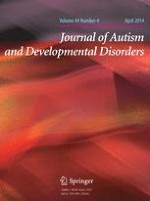01-04-2014 | Original Paper
Social Smiling and Its Components in High-Risk Infant Siblings Without Later ASD Symptomatology
Gepubliceerd in: Journal of Autism and Developmental Disorders | Uitgave 4/2014
Log in om toegang te krijgenAbstract
Impaired affective expression, including social smiling, is common in children with autism spectrum disorder (ASD), and may represent an early marker for ASD in their infant siblings (Sibs-ASD). Social smiling and its component behaviors (eye contact and non-social smiling) were examined at 15 months in Sibs-ASD who demonstrated later ASD symptomatology (Sibs-ASD/AS), those who did not (Sibs-ASD/NS), and low-risk controls (Sibs-TD). Both Sibs-ASD subgroups demonstrated lower levels of social smiling than Sibs-TD, suggesting that early social smiling may reflect elevated genetic vulnerability rather than a specific marker for ASD. Only the Sibs-ASD/AS demonstrated less eye contact and non-social smiling than Sibs-TD, suggesting that different processes, threshold effects, or protective factors may underlie social smiling development in the two Sibs-ASD subgroups.
